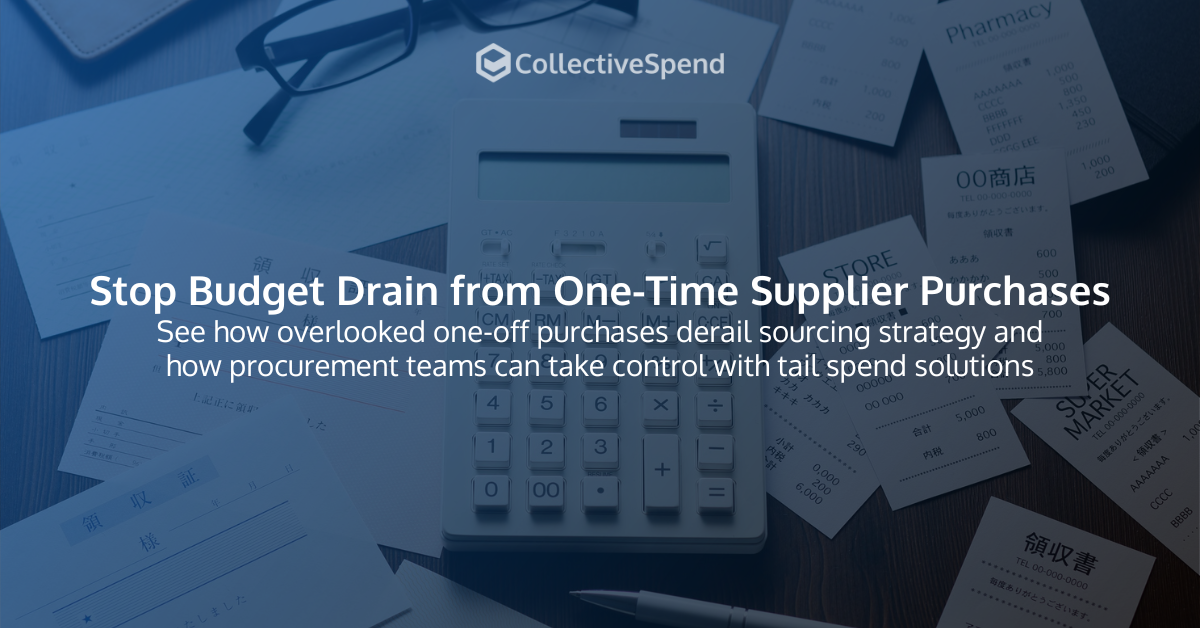Most organizations don’t realize just how much budget disappears through one-time suppliers. The problem often shows up in indirect purchasing, where small or urgent buys bypass standard procurement processes. Without a proper tail spend procurement strategy, these untracked transactions cause cost leakage and lead to budget inconsistencies that feel hard to explain and even harder to control.
The Hidden Drain of One-Time Suppliers
One-time suppliers fill immediate needs. A buyer needs something fast, so they go outside contracted vendors and make a spot buy. It seems harmless in the moment. But repeating this behavior across different teams and departments quickly adds up.
Without contracts in place, pricing is inconsistent. Teams lose out on volume-based savings. There’s no approval process, which leaves the door open to purchasing from vendors with unknown histories or questionable delivery reliability.
Over time, this pattern creates fragmented data. Each one-off transaction lives in a different system, invoiced differently, entered with inconsistent naming, or sometimes not included in reporting at all. Without clean data, spend analysis becomes harder. Budget forecasting gets more guesswork than accuracy.
When “Just This Once” Becomes a Pattern
The phrase “just this once” sounds harmless until it’s repeated across departments every single week. Those one-time purchases chip away at spend control, pulling procurement away from preferred suppliers and negotiated terms.
Every time a purchase goes outside the sourcing policy, it fragments the supply base. Evaluating supplier performance becomes impossible because the engagement was never meant to be strategic. You’re paying for something with zero insight into quality, delivery, or risk.
Manual ordering adds even more exposure. Duplicate purchases happen when two departments source the same item from different vendors. Maverick spending increases. Compliance gaps start with small exceptions that eventually become the rule.
Why Procurement Doesn’t Catch These in Time
These leaks persist because traditional procurement systems aren’t built to catch them. Most tools focus on high-value contracts and core vendor agreements. They miss the small, fast, and frequent transactions that can fly under the radar.
Most teams don’t have tools that track real-time indirect purchases from non-contracted suppliers. Some use email, spreadsheets, or shared drives to handle the tail-end of spend. That level of informality leads to inconsistent records and limited oversight.
Supplier data often lives in separate systems, disconnected from centralized platforms. This makes spend analytics less reliable and makes it hard for procurement to find trends. Without visibility, you’re always playing catch-up, trying to see where the budget went after it’s already gone.
Turning Invisible Spend into Targeted Action
Solving the problem starts with clarity. We review spend history to identify repeat purchases with one-off suppliers and group them into potential savings opportunities. When similar items come up through multiple departments, there’s an opportunity to consolidate suppliers and negotiate smarter terms.
Procurement automation can help by tightening up policy enforcement. That means putting in checks at the point of purchase that prevent off-contract buying and encourage sourcing through established catalogs or vendors.
Platforms built for indirect spend give institutional visibility. By using an e-sourcing tool connected to a larger procurement platform, policy is easier to enforce, and one-off buying becomes the exception, not the rule. The goal isn’t to add friction, but to put thoughtful structure in place.
CollectiveSpend’s tail spend procurement solutions automate spot buys and one-time transactions, keeping spend centralized and compliant without heavy manual intervention.
How Tail Spend Procurement Solves the Budget Puzzle
When we focus on tail spend procurement, we’re targeting the type of spending that often gets ignored. These purchases usually fall below approval thresholds, go to non-contracted suppliers, or happen without a sourcing strategy.
But this “small” spending adds up over time. When managed centrally, it brings some much-needed discipline to an area full of budget loss. Putting rules around who can buy, from where, and how it’s approved gives teams more control without slowing them down.
With better spend analytics, procurement teams stop relying on reactive reviews and start using proactive strategies. Supplier tracking lets us spot recurring issues. Reporting improves. And instead of post-mortem reviews, decisions become more forward-looking.
Shrinking the Small Leak Before It Sinks the Budget
One-time suppliers might seem harmless, but their impact grows the longer they go unmanaged. The lack of contracts, controls, and tracking leaves too much room for waste at best and risk at worst.
With a smarter approach to tail spend procurement, even the smallest transactions are treated with the attention they deserve. We start to make smarter supplier decisions not only for major purchases but for every purchase. That shift doesn’t just stop the leak. It changes how procurement influences the business every day.
When your team is stuck managing low-impact purchases instead of focusing on strategic sourcing, it’s time for a smarter approach. At CollectiveSpend, we help businesses gain control and insights with a dedicated tail spend procurement solution that turns overlooked transactions into meaningful savings opportunities.

